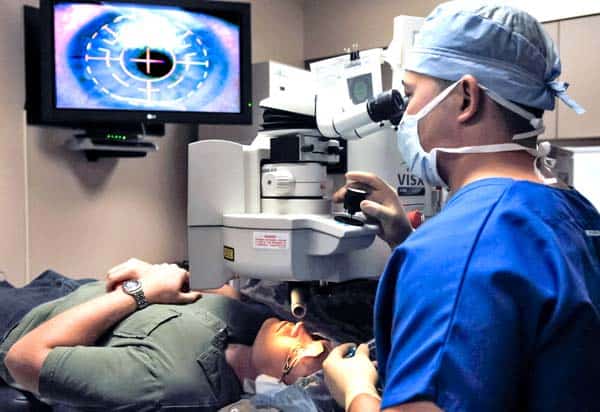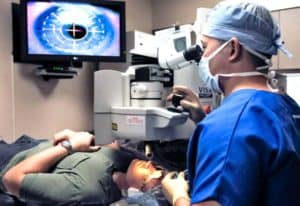Understanding Important Details About Glaucoma
What Is Glaucoma?
Glaucoma is a disease that damages the optic nerve in your eye. It is often associated with a build-up of pressure in your eye and gets worse over time. Glaucoma usually runs in families and generally, it’s not diagnosed until later in life.
Most people with glaucoma don’t show early symptoms or pain. If you lose your eyesight, you cannot get it back. However, lowering eye pressure through glaucoma treatment can help you maintain your eyesight. People with glaucoma who follow their treatment plan, and have regular eye exams, can preserve their eyesight.
What are the causes of glaucoma?
The fluid in your eye is called aqueous humor and usually drains out of your eye through a web-like canal. When this channel becomes blocked, or the eye produces a lot of fluid, it builds up. Sometimes experts don’t know the cause of this blockage. Sometimes it can be inherited, it is passed on from parents to children.
Less common causes of glaucoma include acute or chemical injury to the eye, serious eye infections, blockage of the blood vessels in the eye, and inflammatory disease. It’s rare, but eye surgery to correct another condition can sometimes lead to it. It usually affects both eyes, but it can be worse in either eye.
What are the Different Types of Glaucoma?
There are different types of glaucoma. The two main types are open-angle glaucoma and angle-closure glaucoma. These are characterized by increased intraocular pressure (IOP) or intraocular pressure.
Open-angle glaucoma
Open-angle glaucoma, the most common form of glaucoma, makes up at least 90% of all glaucoma cases:
- It results from a slow clogging of the drainage channels, which increases intraocular pressure. With a wide, open angle between the iris and the cornea, It grows slowly and is a permanent condition.
- Has unnoticed symptoms and damage.
“Open-angle” means that the angle at which the iris meets the cornea is as wide and open as it should be. Open-angle glaucoma is also known as primary or chronic glaucoma. It is the most common type of glaucoma that affects nearly three million Americans.
Angle-closure glaucoma
Acute glaucoma or angle-closure glaucoma is actually less common.
- Is caused by blocked drainage canals, resulting in a sudden rise in intraocular pressure
- Has a closed or narrow angle between the iris and cornea
- Develops very quickly
- Has symptoms and damage that are usually very noticeable
- Demands immediate medical attention.
In contrast to open-angle glaucoma, closed-angle glaucoma results from the angle between the iris and the closure of the cornea.
Vascular glaucoma
Neurovascular glaucoma occurs when the eye creates extra blood vessels covering the part of the eye where fluid naturally flows. It is usually caused by another disease such as diabetes or high blood pressure.
If you have new vascular glaucoma, you may notice the following:
- Pain or redness in your eyes
- Loss of vision
Pigmentary glaucoma
Pigment dispersion syndrome occurs when the pigment (paint) in the iris (the colored part of your eye) flakes off. The loose dye can prevent fluid from leaking out of your eye, increasing eye pressure, and cause pigmentary glaucoma.
Young white men who are nearsighted are more likely to have depigmentation syndrome than others. If you have this condition, you may have blurred vision or see rainbow-colored rings around the lights, especially when exercising.
Glaucoma exfoliation
Glaucoma peels (sometimes called false peeling) are a type of open-angle glaucoma that occurs in some people with peel syndrome. This separates the extra material from the parts of the eye and drains the fluid. Recent research shows that genetics may play a role in the exfoliation of glaucoma. You are at higher risk if someone in your family has exfoliating glaucoma.
This type of glaucoma can progress more quickly than primary open-angle glaucoma and often leads to increased pressure in the eye. This means that it is essential for those at risk to have regular eye exams.
What are the warning signs?
Most cases of glaucoma do not have easily noticeable symptoms, which warns of irreversible damage to the optic nerve. However, the presence of the following warning signs indicates that you need a further examination by an ophthalmologist:
- Difficulty concentrating on near or far objects
- Sensitivity to light
- Excessive squinting or blinking
- Change the iris color
- Eyelids with red, scaly, or swollen edges
- Envisioning ghost-like images
- Double vision is present
- Watery eyes
- Lines and edges appear distorted or wavy
- Difficulty adjusting to dark areas
- Dry eyes with itching or burning
- Long periods of pain in the eyes
The following may provide clues to potentially serious issues that may need emergency medical care:
- Blurred vision
- Halos or rainbows around the light
- Black dots or flashes of light
- Loss of vision in one eye
make sure to seek the advice of your eye doctor if you experience any of these symptoms.
How is glaucoma diagnosed?
Comprehensive eye exams with your ophthalmologist will measure the pressure in your eye (tonometry); Check The drainage angle of your eye (colonoscopy); an Optic nerve evaluation (ophthalmoscopy); and test the field of vision of each eye (perimeter).
Optic nerve assessments and visual field tests are done at regular intervals to monitor the effects of glaucoma.
Who is at risk of developing glaucoma?
It mainly affects adults over 40, but young adults, children, and even infants can develop it. African Americans tend to suffer from it more often when they are younger and are likely to suffer the most from vision loss.
You are more likely at risk for glaucoma:
- African-Americans, Irish, Russians, Japanese, Spanish, Inuit, or Scandinavian descent
- Over 40 years of age
- You have a family history of glaucoma
- Myopia or hyperopia
- Visual impairment
- Take steroids, such as prednisone
- Take certain bladder or seizure control medications or some over-the-counter cold medications
- You have high blood pressure, heart disease, diabetes, or sickle cell anemia
Treatment for glaucoma
Eye Drops
Glaucoma is often treated with eye drops, which are taken regularly, several times a day, sometimes in combination with oral medication. It is important to tell all of your doctors what eye medications you are using, as glaucoma medications can cause side effects. You should tell your eye doctor immediately if you think you might experience any of these side effects:
- stinging sensations
- redness of the eye
- blurred vision
- headache
- changes in heart rate or breathing
The oral medication may have different side effects including; tingling in the fingers and toes, drowsiness, loss of appetite, bowel irregularity, kidney stones, anemia, or bleeding disorders.
Laser therapy
Laser treatment or trabeculoplasty is a treatment to improve the function of eye drainage to control intraocular pressure in open-angle glaucoma. It is a simple treatment that your eye doctor can do right in the office. The doctor will use the laser to try to help fluid drain from your eye. It works by using a laser to help the fluid in your eye drain away, which can help to lower the pressure inside your eye.
Surgery
If surgery is needed to treat glaucoma, your eye doctor will discuss any options available for you. A microscope and special tools are used to create a new lateral drainage channel that causes eye fluid to leave the eyes. The new duct helps reduce eye pressure. Surgery is only recommended if the ophthalmologist believes that the benefit of reducing intraocular pressure provided outweighs the potential complications and/or the subsequent development of optic nerve damage.
Conclusion
Glaucoma is the second leading cause of blindness in the world and affects approximately 5.7 million people worldwide. If left untreated, it can lead to permanent loss of sight. The key to treatment is early detection. Since symptoms are usually not noticeable, it is important to have a routine eye exam, especially if you are African American and/or over the age of 60.
Call the accredited and professionals at Vision Center of New York today to schedule your appointment. Dr. Gary Fishman, MD, and Dr. Simon Wu, MD will work with you to evaluate glaucoma, and determine the best treatment plan for your eyes! Don’t lose your vision to glaucoma, call us today!


